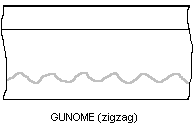The steel for the swords is produced by smelting iron sand in a large clay furnace called a tatara. The steel bloom, or kera, produced contains steel that varies greatly in carbon content, ranging from wrought iron to pig iron. Three types of steel are chosen for the blade; a very low carbon steel called hocho-tetsu is used for the core of the blade, called the shingane. The high carbon steel, called tamahagane, and the pig iron, called nabe-gane, are combined to form the outer skin of the blade, called kawagane.Only about 1/3 of the kera produces steel that is suitable for katana production.
The most famous part of the manufacturing process was the folding of the steel. Japanese swords and other edged weapons are manufactured by the Chinese method of repeatedly heating, folding and hammering the metal. The low carbon hocho-tetsu is folded several times by itself, to purify it. The high carbon tamahagane and the higher carbon nabe-gane are then forged in alternating layers. The nabe-gane is heated then quenched in water, and then broken into small pieces to help free it from slag. The tamahagane is then forged into a single plate, and the pieces of nabe-gane are piled on top, and the whole thing is forge welded into a single block, which is called the age-kitae process. The block is then elongated, cut, folded, and forge welded again. This process, called the shita-kitae, is then repeated from 8 to as many as 16 times. After 20 foldings, (220, or about a million individual layers), there is too much diffusion in the carbon content, and the act of folding no longer gives any benefit to the steel. This process forms the kawagane, (or, skin-steel). Careful positioning of the grain in the steel is used between layers, differing, depending on what part of the blade the steel will be used. The steel is coated in a mixture of clay, water and straw-ash to protect it from oxidation and carburization. The clay, in turn, acts as a flux, pulling impurities out from between the layers.This practice became popular due to the use of highly impure metals, stemming from the low temperature yielded in the smelting at that time and place. The folding did several things:
- It provided alternating layers of differing hardenability. During quenching, the high carbon layers achieve greater hardness than the medium carbon layers. The hardness of the high carbon steels combine with the ductility of the low carbon steels to form the property of toughness.
- It eliminated any bubbles in the metal.
- It homogenized the metal, spreading the elements (such as carbon) evenly throughout - increasing the effective strength by decreasing the number of potential weak points.
- It burned off many impurities, helping to overcome the poor quality of the raw Japanese steel.
- It created up to 65000 layers, by continuously decarburizing the surface and bringing it into the blade's interior, which gives the swords their grain (for comparison see pattern welding).
Generally, swords were created with the grain of the blade (called hada) running down the blade like the grain on a plank of wood. Straight grains were called masame-hada, wood-like grain itame, wood-burl grain mokume, and concentric wavy grain (an uncommon feature seen almost exclusively in the Gassan school) ayasugi-hada. The difference between the first three grains is that of cutting a tree along the grain, at an angle, and perpendicular to its direction of growth (mokume-gane) respectively, the angle causing the "stretched" pattern. The blades that were considered the most robust, reliable, and of highest quality were those made in the Mino tradition, especially those of Magoroku Kanemoto. Bizen tradition, which specialized in mokume, and some schools of Yamato tradition were also considered strong warrior's weapons.
One of the core philosophies of the Japanese sword is that it has a single edge. This means that the rear of the sword can be used to reinforce the edge, and the Japanese took full advantage of this. When finished, the steel is not quenched or tempered in the conventional European fashion. Steel’s exact flex and strength vary dramatically with heat variation. If steel cools quickly, from a hot temperature, it becomes martensite, which is very hard but brittle. Slower, from a lower temperature, and it becomes pearlite, which bends easily and does not hold an edge. To control the cooling, the sword is heated and painted with layers of sticky clay. A thin layer on the edge of the sword ensures quick cooling for a hard edge, with a thicker layer of mud on the rest of the blade causing slower cooling and softer, more bendable steel to allow the blade to bend instead of breaking. When the application is finished, the sword is quenched and hardens correctly. This process also makes the edge of the blade contract less than the back when cooling down, something that aids the smith in establishing the curvature of the blade.
Eventually the Japanese began to experiment with using different types of steel in different parts of the sword.
The vast majority of good katana and wakizashi are of wariba-gitae type. The makuri-gitae is made using two steels, one folded more times than the other, or of a lesser carbon content. When both sections have been folded adequately, they are bent into a 'U' shape and the softer piece is inserted into the harder piece, at which point they are hammered out into a long blade shape. By the end of the process, the two pieces of steel are fused together, but retain their differences in hardness.More complex models allow for parrying without fear of damaging the side of the blade. To make han-sanmai-awase-gitae or shiho-zume-gitae, pieces of hard steel are then added to the outside of the blade in a similar fashion. The last generally accepted model, the shiho-zume-gitae, is quite rare, but added a rear support.



































